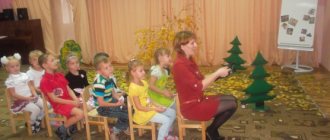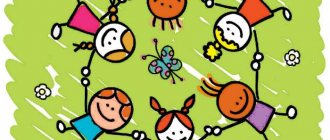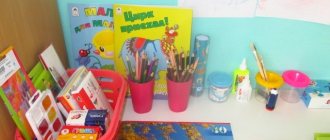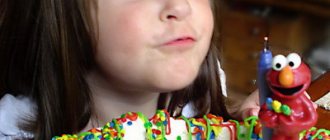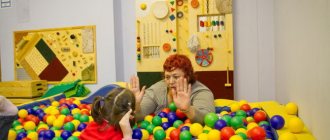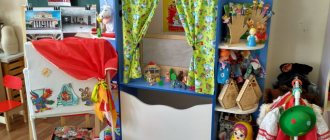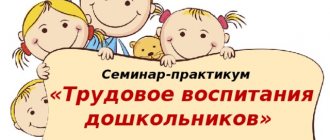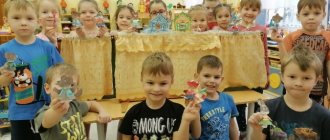The meaning and purposes of theatricalization
Theatricalization is a type of play activity that is used to reveal the creative potential of children using dramatization techniques, that is, role-playing according to a pre-agreed scenario, as well as various exercises aimed at mastering acting skills.
Theatrical performance is an indispensable element of matinees
Theatricalization is valuable because it includes work on the development of monologue and dialogic speech, and this increases the communication skills of children. Theatricalization involves:
- working on the expressiveness of characters’ lines;
- expansion of the child’s active and passive vocabulary;
- improving the pronunciation of speech sounds, as well as intonation structure.
In addition, the goals of theatricalization are:
- comprehensive acquaintance with various manifestations of reality (professions, animals, natural phenomena);
- stimulation of the child’s creative potential (through songs and music, dancing, games);
- development of the child’s emotional sphere due to deep experiences during the game;
- formation of social behavior skills;
- introducing preschoolers to reading;
- development of directing skills;
- embodiment in a creative impulse of the mood, character and process of character development of the character.
Theater is a magical world. He gives lessons in beauty, morality and ethics. And the richer they are, the more successful the development of the spiritual world of children is...
B. M. Teplov, Soviet psychologist
Video: presentation of types of theater for kindergarten (tabletop from knitted toys, on jars, on spoons, shadow theater)
DIY puppet theater
To create a theater you will need a box with sides up to 10 cm high. A cookie box will do. We cover the box with colored paper using double-sided tape.
Let's start creating the curtain. The width of the curtain can be from 3 to 5 cm, the length is the size of the box. On a sheet of red velvet paper, measure the width of the curtain twice and cut off a strip. Then fold it in half, draw the outline of the curtains and cut it out. We cut the finished part along the central fold. We draw folds that imitate the drapery of a curtain with a felt-tip pen. Glue the curtain along the edges of the box.
Then we make a lambrequin. Measure 2 cm in width, draw an outline and cut it out. We measure the length of the lambrequin using the box. We cut it out, draw draperies, and glue it on top of the curtain.
Using a stationery knife, we make a slit up to 1 cm wide on the side of the box, through which the decorations will change.
Backdrops for decorations can be printed or drawn by hand. The size of the pictures must be adjusted to the internal size of the box. If the backgrounds are composed during the course of a fairy tale or play, their change will create the impression of a real theatrical action.
To make the characters you will need juice straws, double-sided tape and printed images of the characters. We fix the cut out figures on the tubes. All is ready! The show can begin.
Work in the theater corner
Activities related to theatrical performances in kindergarten are implemented by several types of play activities:
- Director's games. In them, the child only leads the doll, conveying the image of the character with intonation and some other techniques. The possibilities of pantomime here are also very limited, because the toy is almost static (puppets on canes, puppets).
- Dramatizations. The baby plays the role himself, without resorting to the mediation of dolls. The young actor is able to actively use intonation, facial expressions, movements and gestures to enter into the character of the hero.
- Dramatizations with bibabo, finger, floor or scarf puppets. The baby acts for the character, giving him his voice. The work is carried out from behind a screen or with a character in hand.
Working with floor dolls is very difficult, but exciting for children - you cannot use facial expressions
- Improvisation. Children act out themes, not plots. Such theatrical activity requires almost no preparatory work, but is the most complex type of game. Various theatrical props can be used for improvisation.
The theater corner, which has everything necessary for the relevant activity, allows you to create a comfortable environment in the group for the development of the creative abilities of students. Theatricalization is a special area of the educational program for preschool institutions, because it gives children the opportunity not only to explore the world around them, but also to learn to live in harmony with it. In addition, theatrical performances help children become more self-confident, which is also important for their personal growth - which means that a kindergarten cannot be without a theater corner.
Passport of the theater corner educational and methodological material (senior, preparatory group)
Municipal autonomous preschool educational institution
"Kindergarten No. 69"
Group "Tsvetik - seven-colored"
Theater corner "Bi-ba-bo"
Authors and designers:
Bikchentaeva Ch. Kh.
The theatrical activity corner is located far from the noisy sports corner. Next to the theatrical corner there is an art corner and a library, which allows the child to listen and understand the work, independently “communicate” with the book, leaf through it, looking at the illustrations, discuss it with peers, and then use it in theatrical activities.
Costume room: costumes for fairy tales (animals, vegetables); national costumes (Russian folk costumes for men and women, Ukrainian folk costumes for men and women); costumes of a clown, magician, angel; attributes for dancing: ribbons on sticks, plumes, mittens; wigs; shoes; bags; hats.
Musical instruments: drums, maracas, tribrushes, spoons, pipes, rattles, penny pinches, xylophone, bells, whistles, synthesizer, guitar, tambourines.
Musical games: game for breathing development - “Cheerful Clown”; “The ladder is wonderful”; “Development of musical ear” (find a pair); “Set of bottles with different sounds” (match the sound to the fairy tale); “Who talks like that”; “A Guide to the Staff of Music”; "Children's karaoke."
Equipment: filmoscope and films for viewing; music center with a selection of music library; decorations for theaters - cardboard images (castles, houses), plastic trees; posters; programs; tickets.
Theaters: “Bi-ba-bo”; "Finger Theater" “Mitten Theater” (factory and homemade); "Theater "Tails"; "Theater on a stick"; wooden theater "Bull - Resin Barrel"; "Rag Dolls"; "Tabletop theater"; "Theater on Spoons"
The theatrical corner is intended for children of middle, senior and
yi preparatory group.
Introducing children to theatrical activities from early childhood, to all types of children's theater, which will certainly help improve the child's culture, form a spiritually developed personality, and help activate creative potential.
The following types of activities can be organized in the theatrical corner: gaming, communicative, educational, productive, musical and artistic, and labor.
Game catalogues: breathing development game - “Cheerful Clown”; “The ladder is wonderful”; “Development of musical ear” (find a pair); “Set of bottles with different sounds” (match the sound to the fairy tale); “Who talks like that”; “A Guide to the Staff of Music”; "Children's karaoke."
Working with the family: involving parents in making scenery, making posters for performances and programs, making musical instruments. Master classes for parents on learning to play children's musical instruments, invitations to matinees. Consultations on the topic: “Theatrical and play activities are one of the most effective ways of corrective influence on a child.” The influence of finger theater on the development of fine motor skills.
To ensure an optimal balance of joint and independent theatrical activities of children in the group, a theater zone or fairy tale corner should be equipped, as well as a “quiet corner” in which the child can be alone, look at illustrations for the work, and remember the content of his role. In order to realize individual interests, the subject-spatial environment must ensure the right and freedom of choice. Therefore, in the area of theatrical activity there should be presented different types of puppet theater, screens for display, masks, children's drawings, natural and waste materials, pieces of fabric for mumming.
Speech activity centers can be created in the group, for example, a literary corner. It can be presented in the form of a shelf or an open display case for books, a table and two chairs or a soft sofa, books according to the program and children’s favorite books, portraits of writers and poets, an exhibition of fairy tales.
The list of books for the literary corner may include:
- fiction by topic, 5-6 titles from books read and 1-2 new ones unfamiliar to children;
- "talking books";
- for kids - baby books, toy books;
- handmade books;
- various magazines, looking at illustrations in which helps to develop communication skills;
- audio cassettes with recordings of literary works according to the program.
The group rooms also have space for a theater corner. The following materials are found here:
- tabletop theater;
- screen;
- sets of puppets (finger and flat figures, puppets) for acting out fairy tales;
- theater made by the children and teachers themselves (cones with nozzle heads, various masks, decorations);
- characters with different moods;
- material for making characters and decorations (colored paper, glue, waste material, pencils, paints, scissors and other materials);
- ready-made costumes, masks for acting out fairy tales, homemade costumes;
- substitute attributes (circles of different colors, stripes of different lengths) to designate magical objects and mark out the play space in kindergarten;
- mummering corner from the middle group (ready-made mummery);
- for older children - elements of mummery, wigs, etc.
Equipping a theater corner for the senior group
- Theatrical and play equipment: large and small screens, fences, simple decorations made by children.
- Rack-hanger for suits.
- Costumes, masks, wigs, attributes for staging 4-5 fairy tales.
- The group has different types of puppet theater: picture theater, finger theater, glove theater, parsley theater, marionette theater, shadow theater of figures and masks, cane puppets, puppets with a living hand.
- For theatrical and play activities, there are technical teaching aids: audio recordings of musical works, recordings of sound and noise effects, video library of literary works.
For children four to six years old, toys for theatrical play meet essentially the same requirements as at the previous age stage. However, puppets with a basic control system are additionally recommended here; soft, on strong threads, commensurate with the child’s height.
Festive and carnival toys
Children from four to six years old can be offered large inflatable dolls, animal figures, fairy-tale characters that are easy to carry, all kinds of wands, and emblems.
Festive and carnival toys can be very large and decorative. Surprise toys with effects that imitate fireworks (without the use of fire or flammable materials) are interesting. The attributes of costumes and masks should be created in accordance with the anthropometric and ergonomic data of the children of each group.
The content of work on theatrical activities includes:
- watching puppet shows and talking about them;
- dramatization games;
- preparing and acting out various fairy tales, staging poems;
- exercises to develop expressiveness of performance (using verbal and non-verbal means of expressiveness);
- literary games “Guess the title”, “Guess the name of the hero”, “Remember and tell”.
Shadow theater
Shadow theater is a visual art form that originated in China over 1,700 years ago.
Shadow theater uses a large translucent screen and flat colored puppets operated on thin sticks. The puppets lean against the screen from behind and become visible.
The specifics of the theater, its aesthetics and theme vary depending on traditions.
Puppets were traditionally made from thin transparent skin (for example, goat, camel), paper or cardboard. They can be either solid and integral, or bendable, consisting of separate parts, possibly movably connected. The figurines were controlled using bamboo, wooden or metal sticks.
Finger Theater
Finger Theater is an excellent role-playing game for preschoolers, which:
- stimulates the development of fine motor skills;
- introduces the child to such concepts as shape, color, size;
- helps develop spatial perception (concepts: right, left, next to each other, etc.);
- develops imagination, memory, thinking and attention;
- helps develop vocabulary and activates speech functions;
- develops creative abilities and artistic skills;
- introduces basic mathematical concepts;
The finger theater is a magical world in which a child rejoices while playing, and while playing, he learns about the world around him.
From the first months of life, along with lullabies, nursery rhymes and jokes, the child also gets acquainted with the magical world of fairy tales. From fairy tales, children gain ideas about time and space, the connection between man and nature, good and evil, courage, perseverance, and cunning.
Finger theater is a unique opportunity to place a fairy tale on a child’s palm, in which he can take the role of any hero.
Finger theaters are very good for theatrical activities. Theatrical games create an emotional uplift and increase the child’s vitality; by participating in a home performance, the child feels relaxed and free.
Finger theater is an excellent material for developing children's imagination, thinking and speech. Finger theater promotes the development of fine motor skills. During games, children, repeating the movements of adults, activate hand motor skills. With the help of this, dexterity is developed, the ability to control one’s movements, and concentrate attention on one type of activity.
The finger theater is indispensable for working with children. Games with little characters allow you to stimulate speech activity, since all the warmth, originality, and brightness put into the figurine by the author draws the child into a fairy-tale world, helping to remove various blocks. Play is a natural means of self-expression for a child, and the use of symbolic materials helps him distance himself from problematic (difficult) situations.
The finger theater is a great helper in communicating with a child! Finger puppets “coming to life” on your finger will not let you get bored, and will keep you company during a walk, visiting a clinic or on the road. Finger puppets won't take up much space in mom's purse and will help entertain the baby.
The uniqueness of the finger theater lies in the fact that these are handmade creations. Finger puppets are made with soul and carry creative energy that can be transferred to the one who holds them in their hands.
How to play finger theater?
Options for playing finger theater depend on the age of the child.
At 2-3 years old, children are ready for the simplest scenarios, which are best played with one hand.
From the age of three you can introduce the second hand and complicate the scenario.
At 4-5 years old, children are able to perform several actions that successively replace each other.
First, you should simply introduce the baby to the dolls, let the child touch and examine all the heroes of the fairy tale. Then the characters are put on their fingers one by one and communication with the child occurs on their behalf. You can invite your child to put the doll on his finger and try to communicate with each other. Next, a fairy tale is played out in front of the child. Children better perceive well-known Russian folk tales: “Turnip”, “Kolobok”, “Teremok”. Moreover, it is better to read a fairy tale before this, look at the pictures, discuss the characters and the development of the plot with the child.
At first, finger theater classes are held purely as theatrical performances.
As soon as the baby learns how to play with dolls, you can start performing together. To begin with, you should teach your child to play with one hand; as he grows up, you need to choose more complex fairy tales, poems and songs, consisting of several actions, with a large number of characters.
During theatrical performances, emphasis must be placed on the intonation of speech of each character (the mouse speaks in a squeaky voice, the bear speaks in a bass voice, etc.). This allows the child to develop voice intonation and onomatopoeic skills.
Theater Bi-ba-bo
Bibabo is the simplest doll, consisting of a head and a dress in the form of a glove. The head has a special hole for the index finger, and the thumb and middle finger are used for gesturing with the doll's hands.
Bibabos are often used in traveling puppet theaters.
The Bi-Ba-Bo Puppet Theater or the Petrushki Theater is a theater whose puppets are worn on three fingers of the hand - like a glove. In Italy, these dolls used to be called burattini, now they are called pupatzza. In Russia, this puppet character was named Petrushka.
Parsley is the favorite character among the buffoons who gave performances for the audience. He is a daring daredevil and a bully who maintained a sense of humor and optimism in any situation. He always deceived the rich and government officials. In such a theatrical performance, two heroes acted simultaneously (according to the number of hands of the puppeteer): Petrushka and the doctor (policeman). The plots were the most common, for example, Petrushka gets married or buys a horse. He always participated in conflict situations, and his reprisals were quite harsh, but the public never condemned him for this. At the end of the performance, Petrushka was often overtaken by “heavenly punishment.”
Parsley traveled from fair to fair for a long time, until in 1924. did not finally find his home in St. Petersburg. And it was then that a permanent puppet theater for children was organized.
MAKING BI-BA-BO DOLLS
Bi-ba-bo dolls can be purchased in stores or sewn yourself. The simplest doll consists of a body-shirt, a head and arms. The body-shirt is cut from fabric according to the puppeteer's hand. The head can be made of different materials: wood, bread, plastic ball, papier-mâché. You can also use old dolls and rubber toys. If the doll is difficult to drive, you can use a gapit (a wooden rod with a comfortable rounded handle).
The process of making a doll consists of several stages: selection of material, cutting of parts, stitching, stuffing, assembly.
Theater "Smiley"
Smiley (English: smiley - “smiling” and the direct name of such an icon) or happy face (☺/☻) - a stylized graphic image of a smiling human face; traditionally depicted as a yellow circle with two black dots representing the eyes and a black arc representing the mouth. Emoticons are widely used in popular culture, and the word “emoticon” itself is also often used as a general term for any emoticon (depicting an emotion with punctuation marks rather than graphics).
Theater on sticks
Theater "Rukavichka"
Home theater with the help of mitten toys is an even more exciting activity for a child than ordinary games. After all, in it the child is the main participant and director of the play, and the plot, repertoire, and texts of the “actors” depend on him.
Do kids often demand to read a fairy tale to them? They will enjoy the home theater with mitten toys even more! After all, they will see with their own eyes their beloved characters - Kolobok, Fox, Puss in Boots and many others, and will also be able to touch them.
It’s even more fun to compose and act out your own story. It will be better if the smallest kids first become ordinary spectators, and a fabulous action performed by you appears before them. And over time, the baby will choose his favorite character and join the game.
Puppet home theater with mitten toys is an educational game. It gives children the opportunity to take a closer look at the characters themselves. Also, staging scenes with mitten toys helps the child learn to behave correctly in different situations, distinguish between good and evil, and find a way out of existing problems. The child will learn to understand the characters’ personalities and decide who they want to be like and who they don’t.
Performances with mitten toys develop speech, expressive diction and memory, and enrich vocabulary. Often, a child needs to memorize texts, memorize songs and poems, which may be very necessary in the upcoming school life. The fundamental point: with the help of such a theater, it will be more interesting for children to learn a foreign language, speaking in the voice of different characters in their chosen language. This makes it much more fun and easier to learn new words.
Children's puppet theater develops imagination and creativity. When kids themselves begin to actively participate in productions, they open up a vast field for imagination. After all, you can invent more and more new stories, show them to your friends, and then in kindergarten and school. Maybe in front of you is a future director - a world-class star. And it all started with an ordinary home theater.
A home puppet theater with mitten toys helps children socialize. After all, kids learn to create their own “circle”, their own team, talk among themselves, distribute roles and responsibilities. Home puppet theater performances help a child to relax and overcome his shyness.
After all, working with mitten toys develops the baby’s motor skills. After all, she asks for precision of movements and flexibility of the fingers.
When buying mitten toys for your home puppet theater, pay attention to quality. Mitten toys, like other toys, must be made from environmentally friendly material that does not cause allergies in the baby. Therefore, trust reliable manufacturers of soft toys.
Tabletop theater
A tabletop theater is a layout with scenery and small figures that someone moves around in the layout. This theater is designed for a very small audience. The stage requires a box, one side of which opens to accommodate the backstage and curtain. The space above the box and on its sides is covered with fabric. The decorations are suspended on wires and can be changed from above. The most convenient way to move characters around the stage is with a long stick, which is moved along the floor of the box. Such theater is usually very interesting for children with pronounced inclinations towards modeling and designing small objects.
Spoon Theater
The Spoon Theater anticipates the introduction to more complex riding puppets, being, as it were, a simplified version of them. Making a theater of spoons is not difficult. They are based on a spoon, light and easy to handle. On ordinary wooden or plastic spoons they draw a fairy-tale character (the face of a fox, a wolf, a bun, etc.). You can glue ready-made ones. Then the spoons are varnished (if it is wood). For each finished character, a “skirt” is sewn (to hide the handle of the spoon). Every spoon (now a theatrical character). The child takes the spoon by the handle and lifts it onto the screen. The child's hand is hidden under a skirt, put on a spoon and tied tightly. Such a spoon doll can easily move across the screen, sway, turn in different directions, and dance.
